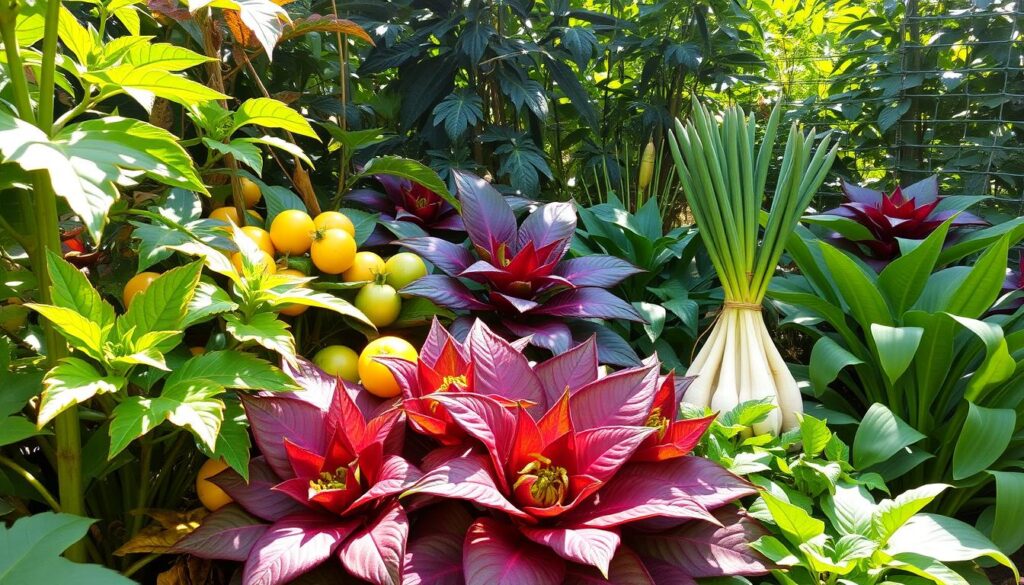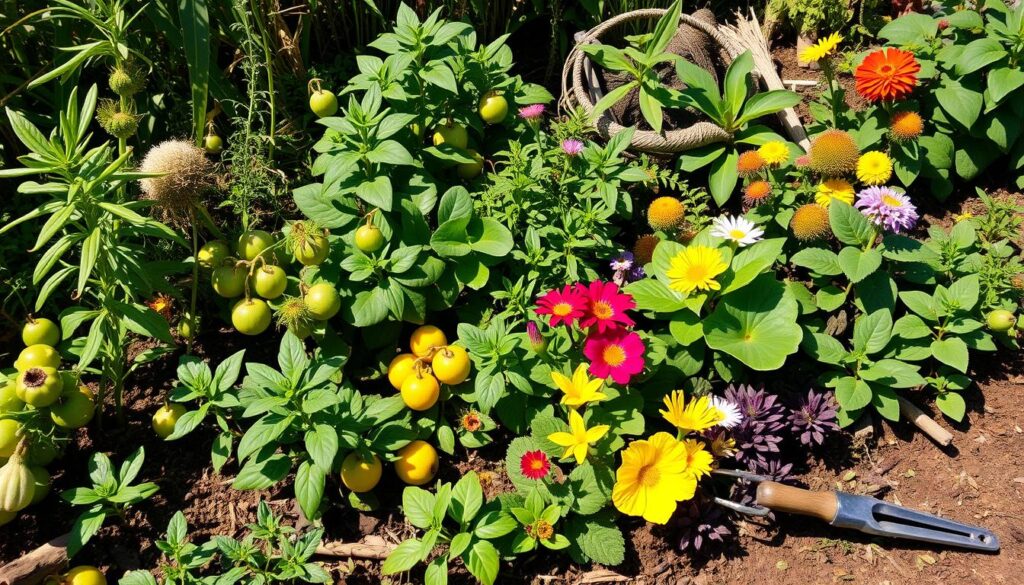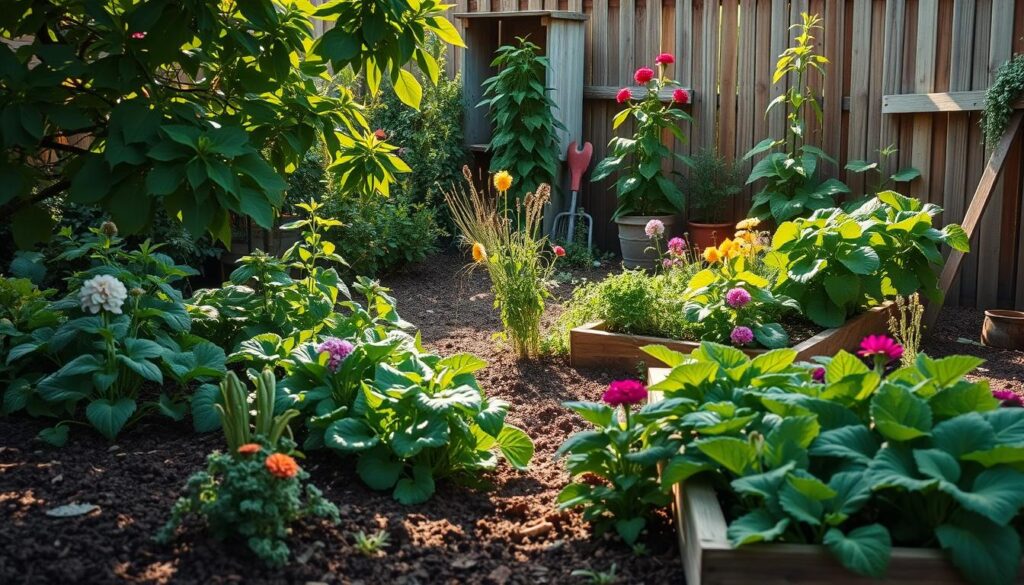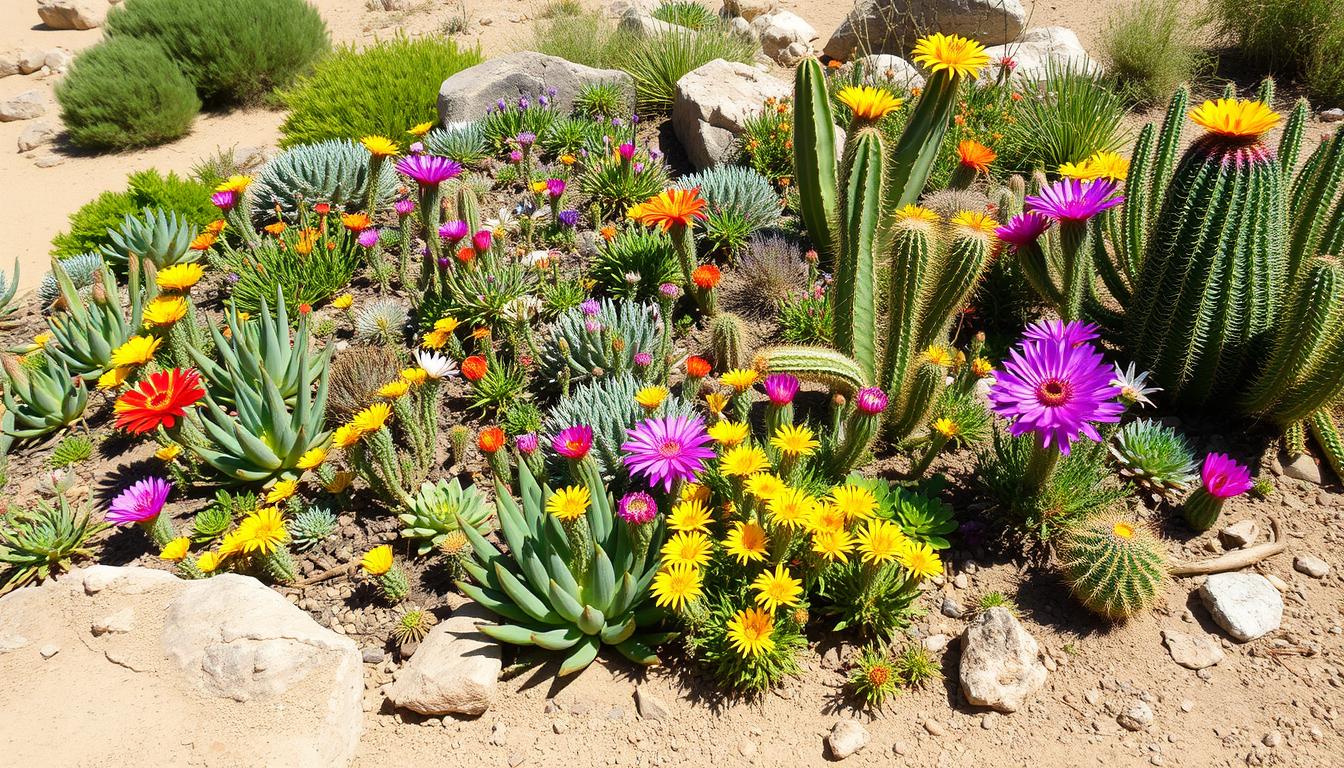Over 200,000 listings for plants, seeds, and bulbs are on eBay. This shows rare edible plants are becoming more popular. Growing these plants in your backyard can be rewarding. It lets you try new flavors and add a personal touch to your garden.

You can grow rare edible plants like leafed hibiscus, chokeberries, and pawpaws. These plants can make your cooking better and help save biodiversity. Seed companies like Baker Creek and Southern Exposure Seed Exchange have many heirloom varieties. This makes it easy to find the right plants for your garden.
It’s important to know how to care for these plants. They need the right sunlight, water, and soil. With the right care, your garden can thrive with rare edible plants.
Key Takeaways
- Over 200,000 listings for plants, seeds, and bulbs are available on eBay, making it easier to find rare edible plants.
- Growing rare edible plants can add a unique touch to your backyard garden and provide new flavors to explore.
- Reputable seed companies like Baker Creek and Southern Exposure Seed Exchange offer heirloom varieties of rare edible plants.
- Rare plant cultivation requires understanding the specific needs of each plant, including sunlight, water, and soil requirements.
- Backyard gardening tips and techniques can help you successfully grow and maintain rare edible plants in your garden.
- Exploring local gardening groups and seed-exchange programs can provide access to rare seeds, roots, and cuttings.
Understanding Rare Edible Plants and Their Benefits
Rare edible plants are a great chance for backyard gardening. They add unique flavors and nutrients to your meals. By learning how to grow them, you can enjoy new tastes and help nature.
Foraging for wild plants like dandelions and stinging nettles is exciting. These plants are full of vitamins and minerals. It’s important to harvest them safely and not too much to keep them around for a long time.
What Qualifies as a Rare Edible Plant
Rare plants need special conditions to grow. They might need certain soil or weather. Knowing this makes gardening them more rewarding.
Benefits of Growing Uncommon Varieties
Uncommon plants add variety to your garden. They also help the soil and attract good bugs. This makes your garden healthier and more diverse.
Environmental Impact and Biodiversity
Growing rare plants helps the environment. It supports biodiversity and cuts down on industrial farming. As people want more sustainable food, rare plants become even more important.
| Plant | Nutritional Value | Culinary Uses |
|---|---|---|
| Dandelion | Rich in vitamins A, C, and K | Salads, soups, sautéed greens |
| Ground Ivy | High in vitamins C and K | Teas, salads, sauces |
| Stinging Nettle | Rich in iron, calcium, and vitamins | Soups, stews, sautéed greens |
How to Grow Rare Edible Plants in Your Backyard
Growing rare edible plants in your backyard can be very rewarding. It lets you add unique flavors and textures to your meals. Each plant has its own needs, like soil, climate, and water. With the right care, you can grow many rare edible plants.
Popular plants for backyard gardens include Stonecrop sedum, mint, and Jerusalem artichoke. They attract pollinators and give you fresh, healthy food. Start by learning what each plant needs, like sunlight and water. You can also ask local nurseries or gardening experts for help.
Here are some key things to think about when growing rare edible plants:
- Choose plants that fit your climate and soil
- Give them the right care, like watering and pruning
- Learn what each plant needs for the best growth

By following these tips and doing your homework, you can make a garden full of rare plants. Whether you’re new to gardening or have experience, growing these plants is fun and rewarding. It makes your meals more exciting and fresh.
| Plant | Climate | Soil | Watering |
|---|---|---|---|
| Stonecrop sedum | Full sun | Well-draining | Low water |
| Mint | Partial shade | Moderate moisture | Regular watering |
| Jerusalem artichoke | Full sun | Rich soil | Regular watering |
Essential Growing Conditions for Unique Edible Species
When growing plants in your backyard, knowing what each needs is key. This is even more important for gardening with rare plants. They often need special conditions to do well. By mimicking their natural habitats, you can grow them successfully in your yard. This includes using rare plant propagation techniques for their health.
Soil quality is a big part of unique edible gardening. You might need to change the soil’s pH, add organic stuff, or use special mixes. For instance, purple cauliflower and yellow eggplant need well-drained soil and lots of sun. On the other hand, stinging nettles and dandelions can grow in many conditions, making them great for backyard horticulture.

Climate is also crucial, as plants have different temperature and humidity needs. By knowing these, you can create the right conditions in your yard. This might involve using greenhouses or cold frames to grow plants longer. It lets you grow more plants and keeps them healthier.
| Plant | Soil Requirements | Climate Considerations |
|---|---|---|
| Purple Cauliflower | Well-drained soil | Full sun |
| Yellow Eggplant | Well-drained soil | Full sun |
| Stinging Nettles | Varied soil conditions | Partial shade |
By giving plants the right conditions, you can have a rich harvest of unique edibles. This supports backyard horticultureand green gardening.
Maintenance and Harvesting Strategies for Exotic Edibles
When growing rare edibles, keeping them well-maintained and harvested at the right time is key. Foodie gardeners must pay close attention to details. This includes pruning, training, and watching out for pests and diseases. For example, citrus trees and figs need regular care and pruning to do well.
Harvesting wild edible plants at the right time is also important. It ensures they taste great and are nutritious.
Starting with uncommon herbs like mint and parsley is a good idea for beginners. These plants are easy to care for and can grow well in small pots or indoors. But, rare edible plants need more care. They might need special soil, climate, and watering. Curry leaf plants, for instance, can adjust to changing seasons. They can be patio plants in summer and indoor plants in winter.
When harvesting rare plants, keep these tips in mind:
- Seasonal availability: plan your harvest based on the plant’s growth cycle and when it’s in season
- Proper handling: be gentle when handling plants to avoid damage and contamination
- Food safety: make sure to follow food safety guidelines when cleaning and storing your harvest
Some plants, like chives, need careful management to stop them from spreading too much. Others, like peppers and chilies, do well in small pots with moderate watering. By following these tips and understanding each plant’s needs, gardeners can enjoy a rich harvest of exotic edibles.
| Plant | Maintenance Requirements | Harvesting Tips |
|---|---|---|
| Citrus trees | Regular pruning and watering | Harvest when fruit is ripe and ready |
| Mint | Low maintenance, can thrive in small pots | Harvest leaves as needed, pinch off flower buds |
| Curry leaf plants | Adaptable to seasonal environmental changes | Harvest leaves and stems as needed, prune regularly |
Conclusion: Embracing the Adventure of Growing Rare Edibles
Growing rare edible plants is an exciting journey. It lets gardeners try new tastes and learn about nature. By growing uncommon herbs and specialty plants, you can also help save biodiversity. With the right organic gardening tips, this journey can be very rewarding.
Whether you’re searching for wild edibles or tending to your garden, gardening is an adventure. It helps you connect with the land and appreciate nature’s diversity. By trying unusual plants, you might find a new favorite food.
FAQ
What qualifies as a rare edible plant?
Rare edible plants are hard to find and not grown much commercially. They have special tastes, textures, or needs. This makes them different from common foods.
What are the benefits of growing rare edible plants in my backyard?
Growing rare plants can add new flavors to your meals. It helps nature and saves money. It’s also a fun hobby.
How do I choose the right rare edible plants for my backyard?
Think about your area’s climate and space when picking plants. Check each plant’s needs for soil, light, and water. Buy from trusted sellers to get the right plants.
What are the essential growing conditions for unique edible species?
Unique plants need specific soil, climate, and care. Soil type, pH, and light are key. Knowing these helps your plants grow well.
How do I maintain and harvest rare edible plants?
Care for rare plants by pruning and watching for pests. Follow each plant’s care guide. Properly handle and store your harvest for safety and quality.
Source Links
- How To Find Rare Edible Plants | The Survival Gardener
- List of 400 edible plants to grow in YOUR garden
- Foraging Edible Plants Right Outside Your Door
- There Are Plants Growing In Your Yard That You Can Eat (No Kidding!)
- 7 Edible Plants Anyone Can Grow At Home (Easy perennials you can eat!)
- These Edible Perennials and Perennial Vegetables to Make a Delicious Edible Landscape — Food Garden Life: Edible Garden, Vegetable Garden, Edible Landscaping
- Unusual native food plants you grow? (Americas)
- 70+ Perennial Vegetables to Plant Once and Harvest for Years
- Foraging for Wild Edibles and Herbs: Sustainable and Safe Gathering Practices
- Edible Backyard Plants | Nebraskaland Magazine
- Exotic Edibles — Know-How for the Edible Garden, Vegetable Garden, and Edible Landscaping — Food Garden Life: Edible Garden, Vegetable Garden, Edible Landscaping
- Edible Plants to Easily Grow in Your Home Garden
- Unique & Unusual Edibles for Sale – Buy Unique & Unusual Edibles
- wildlife garden – Real Gardens Grow Natives
- Growing Joy with Plants – Wellness Rooted in Nature, Houseplants, Gardening and Plant Care




